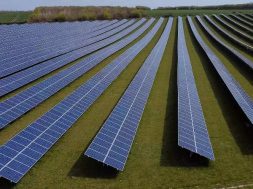
SEIA Insists It’s ‘Foolish’ to Think Tariffs Will Spur Domestic Solar Manufacturing
More than 30 witnesses, including SEIA, will make their case at the final public hearing in the Section 201 trade case Wednesday.
The Solar Energy Industries Association (SEIA) unveiled a plan for President Trump to grow U.S. solar manufacturing on Tuesday, as the administration nears a decision on whether to impose tariffs on imported solar panels.
The recommendations were released in advance of a hearing at the Office of the United States Trade Representative (USTR) in Washington, D.C., where SEIA will present its final arguments against trade remedies sought by petitioners Suniva and SolarWorld.
More than 30 witnesses are scheduled to testify at the last public hearing in the Section 201 trade case on Wednesday. The USTR is tasked with sending its own advice to President Trump on how to handle the controversial trade remedies recommended by the U.S. International Trade Commission (ITC) in October.
SEIA has led the charge in opposing the trade measures, which it says would threaten tens of thousands of U.S. solar jobs. Installers have already stockpiled Chinese panels in anticipation of tariffs, causing prices to spike.
The group’s six-step “America First” plan, which was delivered to the White House, suggests using an import license fee system for imported crystalline silicon PV (CSPV) panels instead of tariffs. The fees would be collected from foreign solar manufacturers and redistributed to U.S. manufacturers.
“It is foolish to think that tariffs will create jobs and will create more domestic manufacturing,” said Abigail Ross Hopper, SEIA’s president and CEO, who spoke at a press event in Washington on Tuesday. “If tariffs are put in place, we’re going to lose more solar manufacturing jobs than we gain.”
“We think with our import license fee that there will be investment here in the United States in cell and module manufacturing, and that will continue to grow,” she added.
SEIA pitched the licensing fee previously to the ITC, where the idea gained momentum with one of the four commissioners. In her recommendations to President Trump, Commissioner Meredith Broadbent proposed selling import licenses at a minimum price of 1 cent per watt. At that rate, SEIA says the government would collect $384 million over three years.

Other steps in the plan focus on the benefits of not imposing tariffs, as well as a request to keep solar costs down for the military in order to bolster national security.
“It’s a clear and concise plan that I think is entirely resonant with the administration,” said Hopper.
More than 200 solar workers from around the country are expected to gather for a rally outside the USTR building on Wednesday afternoon, followed by a march to the White House. The trade agency has received more than 1,500 public comments from industry groups, businesses and solar workers, the vast majority of which called on the government to reject the tariffs.
SunPower CEO Tom Werner told GTM the currently proposed trade remedies “the worst of all worlds.” It hurts U.S. demand, it hurts U.S. companies and “it doesn’t solve the petitioners’ problems, in my opinion,” he said.
U.S.-based manufacturers Suniva and SolarWorld brought the Section 201 case earlier this year, citing serious financial harm due to cheap solar imports. Suniva filed for Chapter 11 bankruptcy protection in April, while SolarWorld raised $6 million to keep its doors open and its factory operational while fighting the trade case.
Emails recently obtained by E&E News show that Suniva was in talks with trade officials at the USTR as early as March, almost a month before it launched its petition for trade relief with the ITC. While it’s not unusual for a company to reach out to federal trade officials in advance, the messages show that Suniva was planning the move before it filed for bankruptcy.
Numerous companies have shown interest in acquiring Suniva, including China-based LONGi Solar and Canadian Solar, according to bankruptcy filings. It’s unclear whether an acquisition would cause the Georgia-based company to re-launch its U.S. operations.
SolarWorld and Suniva have expressed disappointment at the recommendations made by the ITC, which fell short of the import relief they originally requested.
Two out of four commissioners were in favor of placing a 30 percent ad valorem tariff on imported CSPV modules, to decline by 5 percentage points per year over four years. For imported solar cells, they agreed on a four-year “tariff-rate quota” that would allow for up to 1 gigawatt of tariff-free cell imports. Any imports over 1 gigawatt would be subject to a 30 percent tariff. Each subsequent year, the tariff rate would decrease by 5 percentage points and the in-quota amount would increase by 0.2 gigawatts.
“The tariffs that the commission proposed are much less than what the petitioners asked for … but the job loss would still be in the tens of thousands,” said Hopper.
Last week the head of the USTR, United States Trade Representative Robert Lighthizer, asked the ITC to prepare a supplemental report to help the President determine an appropriate way to help the domestic industry adjust to import competition “and provide greater economic and social benefits than costs.” He also asked the commission detail any “unforeseen developments” that caused domestic solar manufactures to be injured by cheap foreign imports.
The request for extra information pushes the deadline for Trump’s final decision on import duties from January 12 to January 26, 2018. He has the authority to adopt one of the ITC’s recommendations, devise an alternative, or do nothing.














